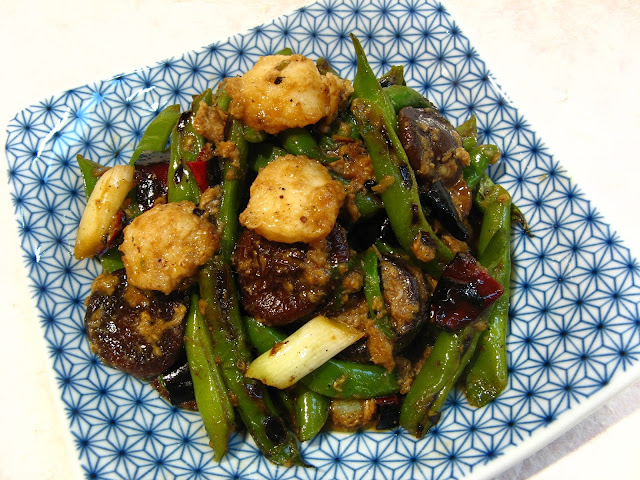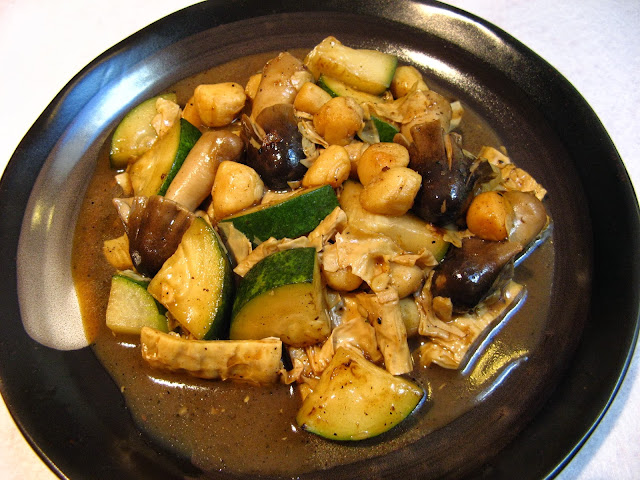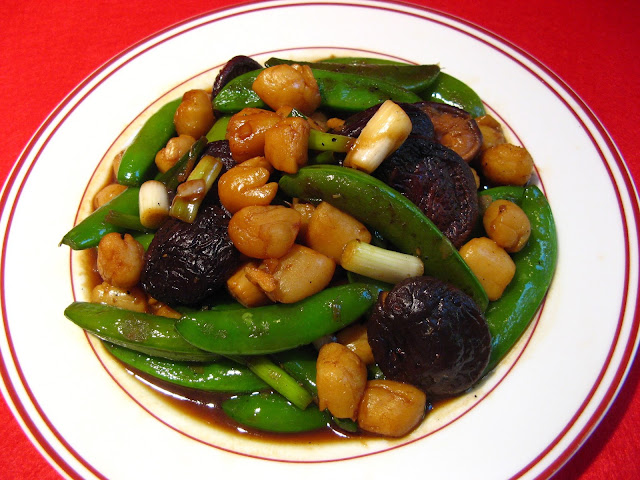Doubanjiang is a spicy fermented broad bean paste. When
using Doubanjiang, the paste is first stir fried until the paste turns a dark
red color and then the meat is stir fried in the Doubanjiang. Stir frying the Doubanjiang
enhances the flavor and is similar in technique to stir frying curry paste in
curry dishes. Stir frying the Doubanjiang and the meat is done at the end of
the cooking process, which is different from usual stir fry dishes where the
meat is cooked first.
Scallops and Shabu Shabu Beef Rib Eye is a stir fried version
of the American classic combination dish referred to as “surf and turf”, where “surf”
is the seafood and “turf” is the beef. This spicy stir fried version of surf and
turf uses thin sliced beef rib eye usually destined for Shabu Shabu, which is a
Japanese dish where the beef is swished in a hot broth before eating. The thin
sliced beef can be purchased at your local Asian market (usually frozen). In
this case I got the Shabu Shabu beef rib eye fresh from my local Japanese
market.
Enjoy!
Ingredients
|
1 lb.
|
500 g.
|
Scallops (扇貝, sin3
bui3)
|
|
½ Tbs.
|
7.5 ml.
|
Corn starch (粟粉, suk1 fan2)
|
|
½ Tbs.
|
7.5 ml.
|
Shaoxing rice
wine (紹興酒, siu6 hing1 zau2)
or dry sherry
|
|
½ tsp.
|
2.5 ml.
|
Ground white
pepper (白胡椒, baak6 wu4 ziu1)
|
|
1 tsp.
|
5 ml.
|
Sesame oil (麻油, maa4 jau4)
|
|
|
|
|
|
1 lb.
|
500 g.
|
Shabu Shabu beef rib eye (涮涮锅肉眼牛排,
saan3 saan3 wo1 juk6 ngaan5 ngau4 paai4)
|
|
½ in.
|
15 mm.
|
Knob of ginger
(薑, goeng1), crushed in a garlic
press
|
|
2 cloves
|
2 cloves
|
Garlic (蒜, syun3), crushed in a garlic press
|
|
1 Tbs.
|
15 ml.
|
Corn starch (粟粉, suk1 fan2)
|
|
2 Tbs.
|
30 ml.
|
Soy sauce (豉油, si6 jau4)
|
|
1 Tbs.
|
15 ml.
|
Hoisin sauce (海鮮醬, hoi2 sin1 zoeng3)
|
|
2 Tbs.
|
30 ml.
|
Shaoxing rice wine (紹興酒, siu6 hing1 zau2)
or dry sherry
|
|
½ tsp.
|
2.5 ml.
|
Ground white pepper (白胡椒, baak6 wu4 ziu1)
|
|
1 tsp.
|
5 ml.
|
Sesame oil (麻油, maa4 jau4)
|
|
|
|
|
|
1 lb.
|
500 g.
|
Sugar snap peas (蜜豆,
mat6 dau6)
|
|
8 oz.
|
227 g.
|
One package fried
tofu (油炸豆腐, jau4
zaa3 dau6 fu6)
|
|
3 stalks
|
3 stalks
|
Green onions (葱, cung1),
cut into ½-inch (15 mm.) pieces on the diagonal
|
|
1 in.
|
2.5 cm.
|
Knob of ginger (薑,
goeng1), thinly sliced
|
|
4 cloves
|
4 cloves
|
Garlic (蒜, syun3),
thinly sliced
|
|
|
|
Oil for cooking
|
Sauce Ingredients
|
2 Tbs.
|
30 ml.
|
Salted black bean (豆豉,
dau6 si6)
|
|
3 Tbs.
|
45 ml.
|
Sichuan Pixiandouban brand Doubanjiang (郫縣豆瓣酱, pei4
jyun6 dau6 faan6 zoeng3) or
equivalent
|
|
|
|
|
|
1 Tbs.
|
15 ml.
|
Soy sauce (豉油, si6
jau4)
|
|
½ Tbs.
|
7.5 ml.
|
Hoisin sauce (海鮮醬, hoi2
sin1 zoeng3)
|
|
1 Tbs.
|
15 ml.
|
Shaoxing rice wine (紹興酒,
siu6 hing1 zau2) or dry sherry
|
|
½ tsp.
|
2.5 ml.
|
Ground white pepper (白胡椒,
baak6 wu4 ziu1)
|
|
½ Tbs.
|
7.5 ml.
|
Sesame oil (麻油, maa4
jau4)
|
Equipment
|
|
|
Garlic press
|
|
8 qt.
|
7.5 L.
|
Pot to parboil the beef tripe
|
|
14 in.
|
35.5 cm.
|
Wok or pan
|
Preparation Instructions
- If using frozen scallops, thaw the scallops overnight in a covered container in the refrigerator. Take the scallops out of the refrigerator one hour before cooking. Marinate the scallops with corn starch, Shaoxing rice wine or dry sherry, ground white pepper, and sesame oil.
- Marinate the Shabu Shabu beef rib eye in a covered container for at least one hour or overnight in the refrigerator with the ginger and garlic crushed in a garlic press, corn starch, soy sauce, hoisin sauce, Shaoxing rice wine or dry sherry, ground white pepper, and sesame oil. If marinating the beef overnight, take it out of the refrigerator at least one hour before cooking.
- Wash and remove the string from the sugar snap peas by grasping each sugar snap pea in one hand and pulling the tip the length of the sugar snap pea with the other.
- Open and drain any liquid from the fried tofu package.
- Thinly slice the ginger and garlic and put into a small bowl.
- Wash and cut the green onions into ½-inch (15 mm.) pieces on the diagonal.
- Wash and lightly crush the salted black beans in a small bowl. Put the Sichuan Pixiandouban brand Doubanjiang or equivalent into the bowl and mix the ingredients together.
- Prepare and mix the other sauce ingredients in another small bowl: add the soy sauce, hoisin sauce, Shaoxing rice wine or dry sherry, ground white pepper, and sesame oil.
Cooking Instructions
- Heat a wok or pan over high heat before adding oil and then the scallops. Stir fry the scallops until brown by forming one layer of scallops in the wok and leaving the scallops alone for a while before flipping it over to brown the other side. You may have to stir fry the scallops in batches, so be sure to reheat the wok over high heat before adding more oil. Transfer the browned scallops to a bowl.
- Reheat the wok over high heat before adding oil and then the fried tofu. Stir fry the fried tofu and then transfer to the bowl with the scallops.
- Reheat the wok over high heat before adding oil and then the sugar snap peas. Stir fry to brown the sugar snap peas. Add the bowl with the ginger and garlic mixture to the wok, and then some oil to the mixture. Quickly stir fry all the ingredients until the ginger and garlic become fragrant. Transfer the contents of the wok to the bowl with the scallops.
- Reheat the wok over high heat before adding oil and then the bowl with the Doubanjiang. Stir fry the Doubanjiang until it becomes darker (red) in color before adding the beef. Stir fry to brown the beef before adding the green onions and the contents of the bowl with the scallops back into the wok, and stir fry all the ingredients together.
- Add the rest of the sauce ingredients to the wok and mix the ingredients together. Put the cooked ingredients into a serving dish, and serve with Clay Pot Rice (煲仔飯, Bou1 Zai2 Faan6) or steamed rice.
















